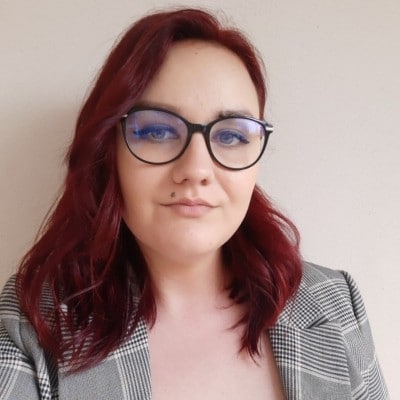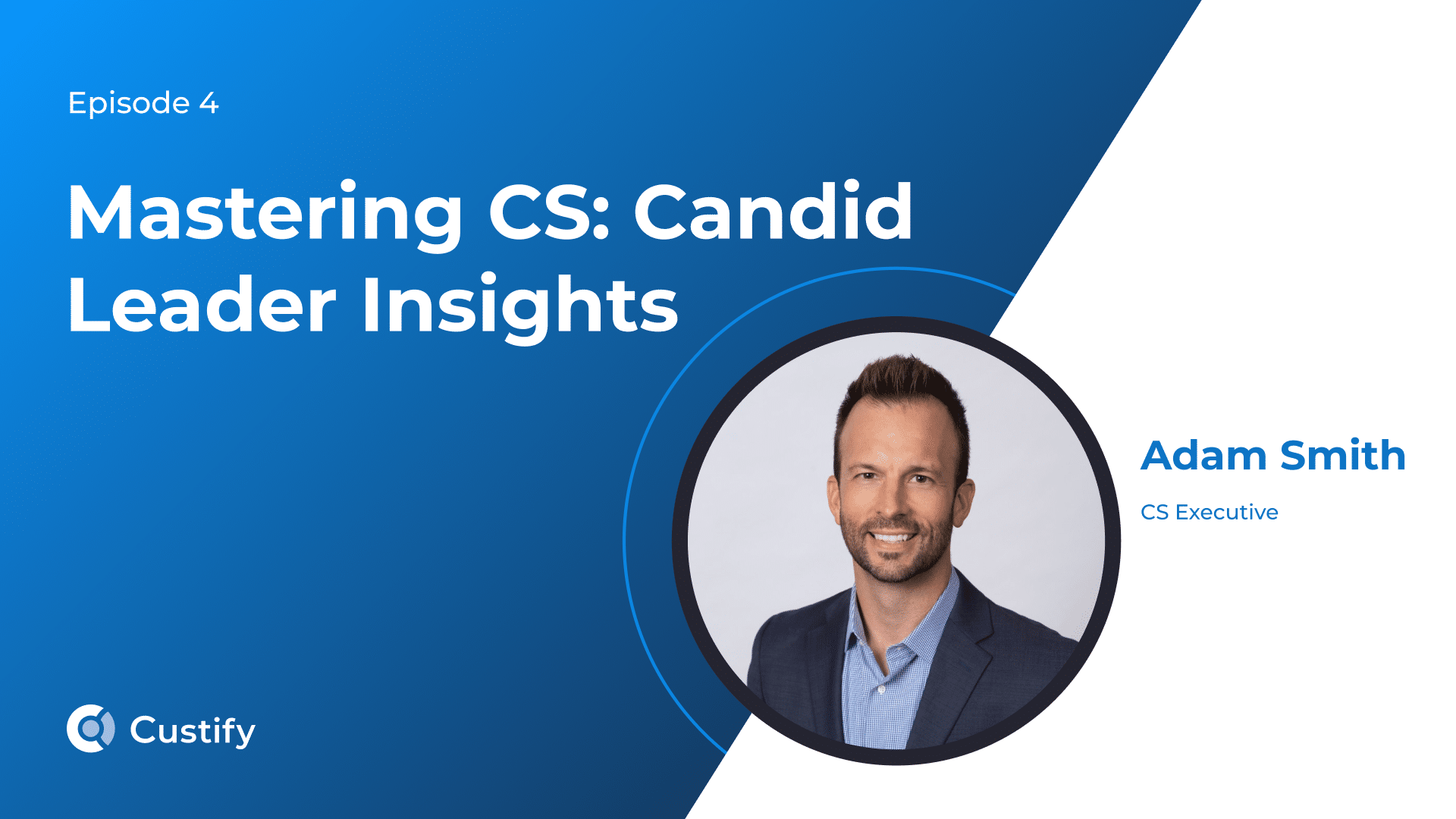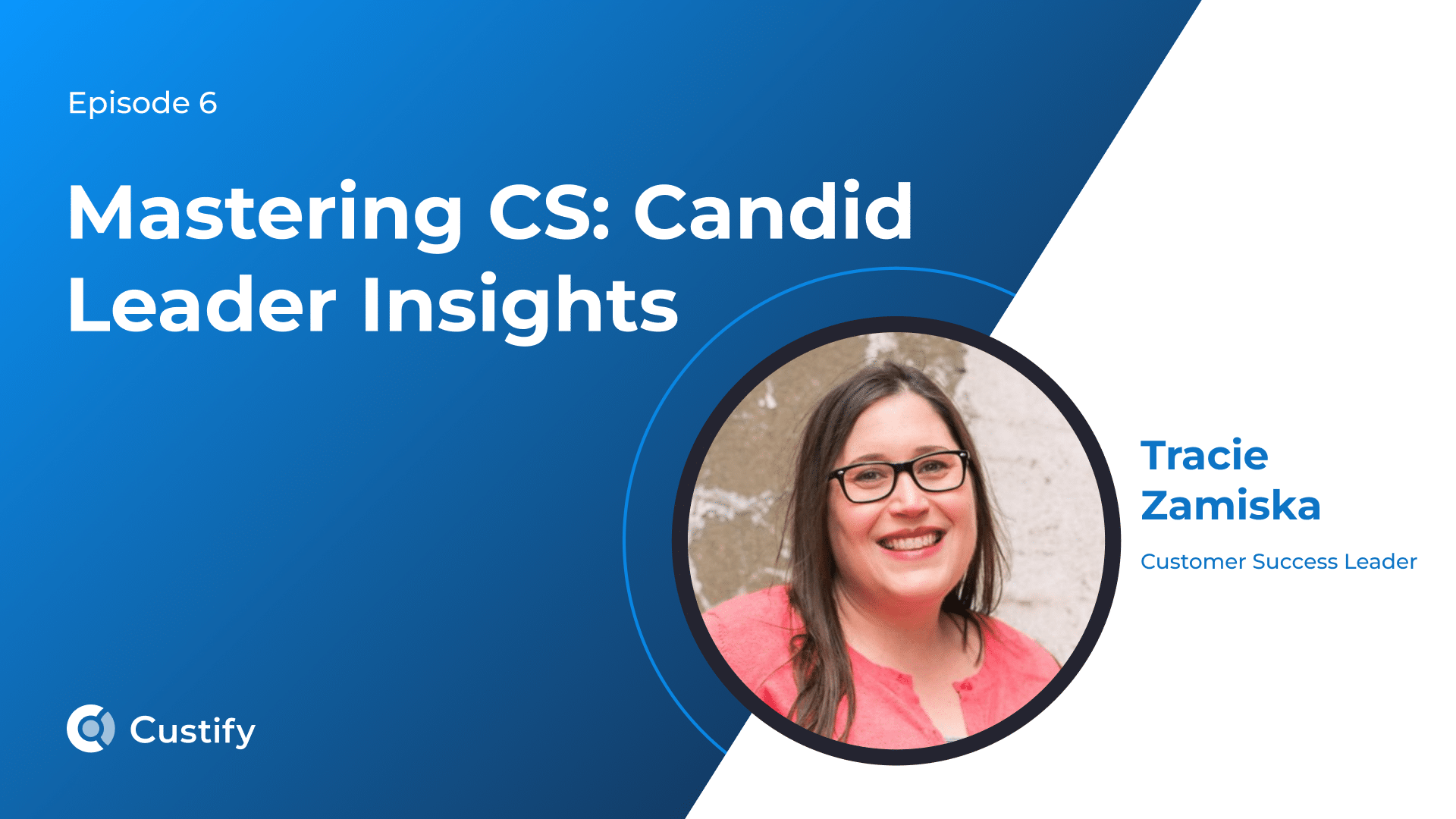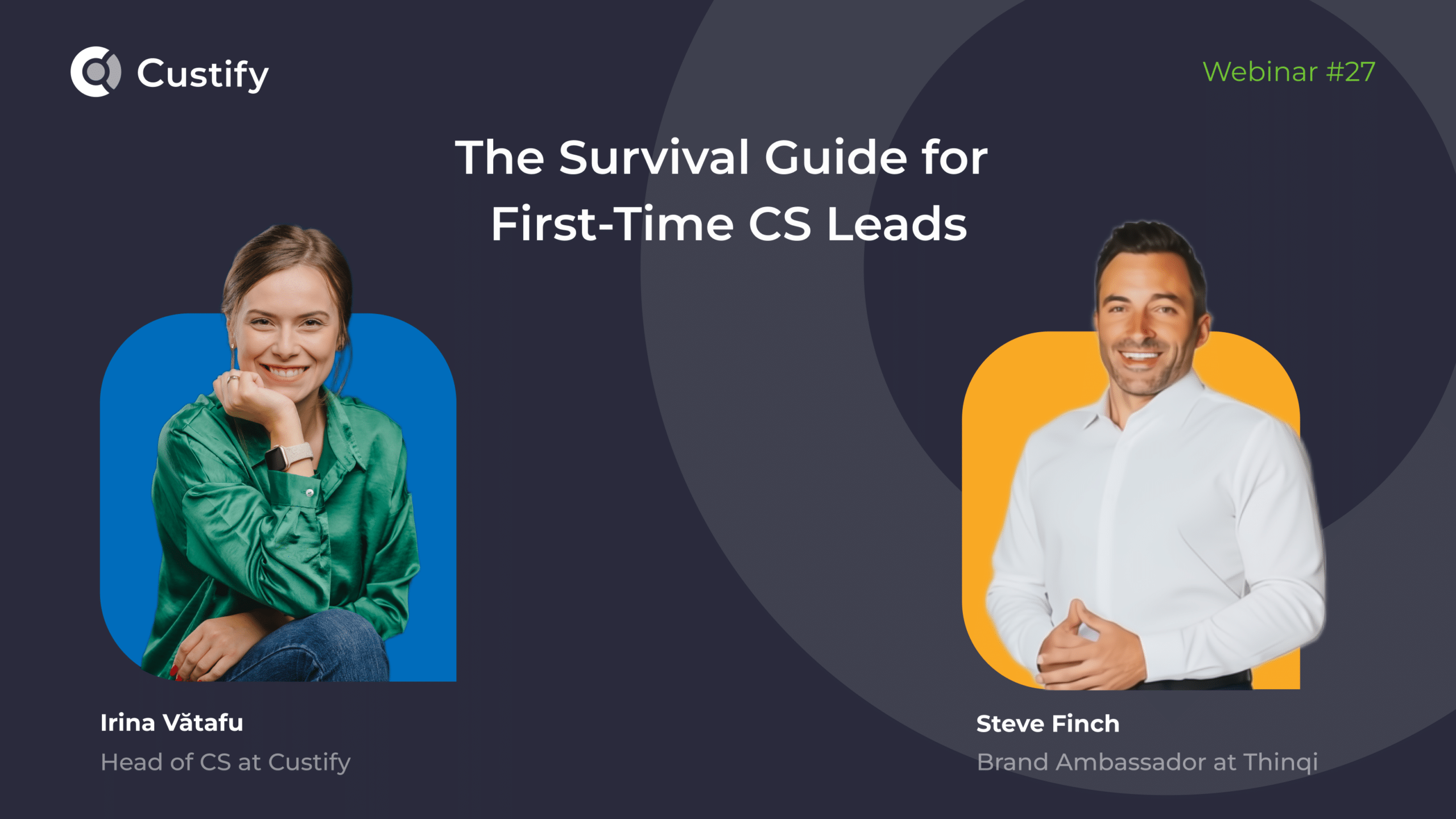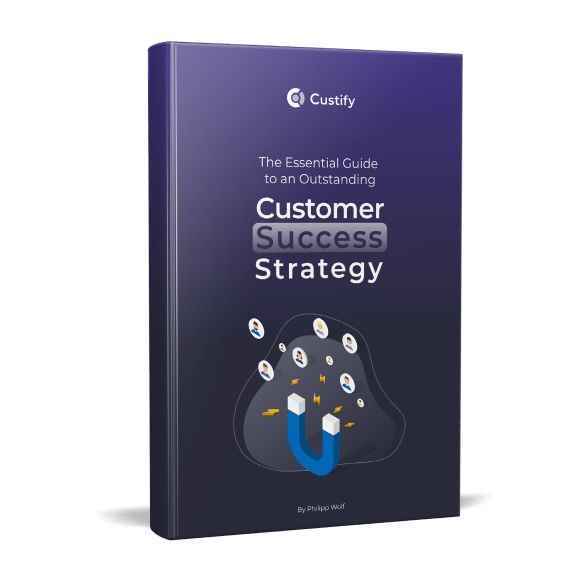In this new episode of the Mastering CS podcast, Irina Cismas, Custify’s Head of Marketing, sits down with Sara Vera-Cruz Quintas, Customer Care & Success Manager at CargoFive.
Sara shares how a career spanning customer service, Brazil-based coordination, procurement, and sales shaped her CS approach; why negotiation is core to every phase of the lifecycle; how she runs a combined Customer Care + CS org; and where adoption most often gets stuck—and what to do about it.
Let’s dive into Sara’s path and the hard-won lessons she’s applying today.
What You’ll Learn
- How sales & procurement skills translate to everyday CS negotiation
- Structuring one team across Customer Care and Customer Success
- Building a rigorous sales → CS handover and onboarding flow
- When (and why) high/medium/low-touch must change with company goals
- Turning data into action: the dashboards and signals that matter
- Spotting adoption risk early and moving accounts toward growth
- Practical advice for new CSMs on personas, patience, and clarity
Key Insights & Takeaways
- Negotiation is constant in CS. It shows up in adoption trade-offs, expansions, and renewals—not just commercials.
- Farmer mindset wins. Trust, transparency, and relationship depth power expansion more than “hunting.”
- Care + CS = one view. Unifying support signals with CSM motion enables faster, proactive saves.
- Adoption is the danger zone. Time-boxed stages and clear success metrics keep accounts moving.
- Data must be visible company-wide. When Product/Dev/Sales share CS context, customers feel it.
- Meet personas where they are. Adapt enablement to generation, role, and comfort with tech.
Podcast transcript
Intro
Irina (0:01)
Welcome to Mastering CS Candid Leader Insights, the podcast where we dive deep into the world of customer success with industry leaders. I’m your host, Irina Cismas, and today’s guest is Sara Vera Cruz, Customer Care and Success Manager at CargoFive. Sara, welcome and thank you for joining us today!
Sara (0:23)
Thank you, thank you so much for your time and for the invitation.
Early Career and Path to Customer Success
Irina (0:27)
I did a bit of research and I noticed that you’ve done quite a lot of things. You’ve gone into logistics, into sales, into procurement. What made you jump into customer success, and what keeps you hooked?
Sara (0:44)
Okay, good question. When I started working at 21 years old, I started in customer service and I already knew that I was good with customer relationships, getting trust, and so on.
I felt I had an advantage in how I relate to customers and earn their trust. Early on I knew it could be a good path. Then I had an opportunity to go to Brazil.
In Brazil I stayed in customer service as a coordinator of eight people. It was challenging because I had to meet expectations of different cultures. Brazil and Portugal share a language, but the culture is very different. I needed to understand how to be a better coordinator, how to help customers, and also the team.
I saw I could help customers and manage a team. People trusted me with personal issues and professional paths. I like to be transparent for customers and for my team.
Then I came back to Portugal and had an opportunity to work in procurement and sales. For me, procurement and sales are not the same, but the goal is the same. In procurement you want to reduce costs. In sales you want to increase outcome. You need to negotiate in both.
I really like to negotiate. I knew I could be a good salesperson because I like negotiation. I had the customer service background that allowed me to get trust more easily with customers, so I tried it. It was a good fit.
In procurement and sales, negotiation was a strong, positive outcome. I stayed in sales a while, doing the full funnel. SDR with cold calling to book meetings, then consultant, then account executive. Always metric driven and negotiation focused and keeping customer trust.
About five years ago I saw customer success. I was already a key account manager and thought it was the same, but it is not. In sales I was ready to be a farmer. I was a little tired of hunting and searching for new opportunities. I was curious how I could expand partnerships with in house customers.
Then my path in customer success started. That was the process.
Translating Sales and Procurement Skills to CS
Irina (5:52)
While you were sharing your journey, several questions popped up. You mentioned procurement and sales being similar in some ways with negotiation in common. You also moved from a hunter profile to a farmer one, which created the foundation for customer success.
How do you use those skills in your day to day? Does negotiation help in the relationship with your customers? What else besides the farmer traits do you use from your sales profile?
Sara (7:02)
In my perspective, in customer success you need to know how to negotiate. You are always negotiating. Expansion with add ons, renewals, and also in adoption. If a customer has hundreds of requirements, you need to balance. You want 100, I can give you 15 right now. Can we work with that.
It is essential to negotiate in CS and to have the farmer intuition from customer service together with sales. Especially if you own the full process from onboarding to renewal. Some companies split growth and renewals to sales, but if you own all of it, you need both.
We need to be proactive, but also react quickly when we cannot be proactive. You get that by dealing daily with customers.
At CargoFive we unified Customer Care and Customer Success in the same department. The roles are not the same, but we are one team so everyone knows customer tiers, pain points, requirements. One point of communication, no bouncing across teams. Right now it is working.
Role, Responsibilities and Team Structure
Irina (10:03)
You are leading both units, Customer Care and Success. What is the setup and how do those teams work together.
First, your roles and responsibilities. Are you responsible for the whole user journey from sign up until offboarding Is that correct?
And does this role start in sales. How do you work with sales from your perspective? I am curious about the process and setup at CargoFive.
Sara (11:11)
Yes. Sales is a different department, but the handover must be very detailed. Company context, trial insights if there was a trial, initial requirements or expectations, and the aim for contracting our platform so we can measure outcome and success.
Sales has a key role at the beginning. With that info, Customer Care does the setup of the account. Users and everything. Then we start onboarding after the kickoff call.
We run a kickoff before demos to meet the owner, align expectations, and be transparent about goals and what we can achieve in the first year.
So the flow is setup, kickoff, demo, then the customer journey. Onboarding, adoption, growth, renewal, off boarding if needed.
Customer Care talks to customers all day. They know platform errors, delays, and requirement volume. That inbound feedback is shared with CS. For example, at week’s end I know if a customer has many doubts. Then we can proactively ask to meet, share a playbook, or jump on a call.
Customer Care also owns help center articles and dashboards. They support CS with a full picture of active users versus dormant or ghosting users. Those need different approaches.
Touch Model and Flexing to Company Goals
Irina (15:09)
Do you have a mixed CS strategy, high touch with low touch? What did you deploy across your portfolio?
Sara (15:22)
We try to have high, medium, and low touch. However, it depends on company goals. If the quarterly OKR is activate users, then most accounts may need high touch. We align with company goals first, then work backward.
We have a base. Tier 1 high, Tier 2 medium, Tier 3 low. It is hard because we want to give customers the same treatment. A three-year customer might be Tier 3, but we have a close relationship. You do not want to reduce touch to once a month just because of a box. It depends. You still need a line for orientation, but it can be dynamic.
First 90 Days, Building the CS Strategy
Irina (17:19)
When you join a new company, or when you first joined CargoFive, what is the first thing you do to shape the customer strategy?
Sara (17:45)
The beginning is always the same. First understand the business model, how many customers you have, and the company background. How they are growing or not. Look at metrics like NRR and churn to guide what is tangible in a new strategy.
Talk to the team to see what is working and what is not. Do not assume everything is wrong. Keep what works and focus on pain points where you can add value.
Then define KPIs, health score, and which metrics to include so you get accurate feedback on customers.
Data, Dashboards and Health Signals
Irina (19:40)
Which dashboards or reports do you need to stay on top of customer health? How do you slice and dice the data, formats and metrics?
Sara (20:07)
We use a lot, but the base is a good CRM.
Irina (20:19)
It is more important to have good data in the CRM, because having a CRM alone is not enough. The data is critical.
Sara (20:39)
Yes. We assume when you have a CRM, the data will be there, but that is a pain point. It is impossible to connect every tool via API and have all data centralized.
We manage with different tools and workflows to automatically bring data into the CRM. Product usage, tickets, feedback. Then we can see the full image.
It is mandatory for me to have a tool to measure retention. Registered versus active users, dormant or inactive users, weekly search trends versus previous weeks. Flat, increasing, or not. We also measure expansion opportunities and track the customer journey.
If health score and feedback are positive and activity is increasing, that is a signal to move the customer to growth and maybe do a case study. Also a good moment for upsell or to prepare a renewal proposal based on activity.
We must also check if we are achieving the fundamental goal for why they hired CargoFive.
Retention in Logistics and Why CargoFive Is Different
Irina (23:24)
Retention is always a pain point in logistics. Is it the same for you? What has been the hardest part?
Sara (23:41)
It is different because we are in logistics, but we are like a Booking.com for freight forwarders. We centralize and speed up their search for opportunities.
In logistics retention, a customer may close with you this month because you are cheaper, and next month with someone else. It is dynamic. That does not impact CargoFive directly. We are not brokering deals. We centralize procurement so they can quote faster on the platform.
What impacts us are market fluctuations. Drops in international trade, sanctions, inflation, and similar factors. That affects freight forwarders. If business drops, tooling investment drops. We must understand how the market affects customers and how we can help them stay with us.
Biggest Bumps on the Journey: Adoption
Irina (25:48)
From onboarding to offboarding is a long road. Where do you usually hit the biggest bump, and how do you handle it? What is the trickiest phase for your team?
Sara (26:43)
Right now, adoption. Our time to value is under 30 days, a good metric, so onboarding is solid. We were keeping customers in adoption too long.
We created a new strategy with timelines for each stage. Adoption cannot exceed specific days or months. We set metrics we must hit to move accounts to growth.
Previously we were very renewal focused. That is common in CS. People chase NRR and retention, so three months before renewal you are there, and you miss adoption because those customers have already moved toward renewal.
Now we structure clearly and changed the CRM so adoption is its own focus. If activity drops, we move fast to find the pain points. Otherwise we lose the chance to grow the account. So yes, adoption.
Next Year, Team Expansion and Making Data Visible
Irina (29:17)
As we enter Q4, what initiative are you most excited to drive next year, besides cracking adoption
Sara (29:49)
We are expanding the team as well. That is exciting.
Irina (29:58)
I will make sure everyone interested in a CS role connects with you on LinkedIn.
Sara (30:11)
We are expanding now. We also need to make all the data visible. Every activity with the customer should be visible to the whole company.
We want the entire company connected to CS. If Customer A is worth 20,000 per year, has four open requirements, and reports one error per quarter, that should be shared with Operations, Development, Product, and Sales.
CS will define and measure data at each stage and share the relevant, filtered view with other teams. We will run more regular meetings with Product on roadmap and requirements and with Development to calculate ticket resolution time.
These interdepartment matters directly impact customers. If the whole company is customer centric, the customer feels it. The impact is positive.
Irina (32:39)
If someone is just starting out in customer success, what is one piece of advice you would give them?
Sara (33:01)
Understand the personas inside your customers. Do not assume a good product means everyone will understand it. You will have Gen Z, Baby Boomers, and Millennials. Different generations and personas who work differently.
If I treat all personas as high tech or assume they understand what I am sharing, I could lose the customer. Be customer-centric and know who is on the other side.
Put yourself in their shoes. If you design a tool that requires one click, your customer might click twice, and that is okay. Adapt to how they work.
Irina (34:30)
Thank you so much, Sara, for sharing your insights with us today and a big thank you to all our listeners. Until next time, stay safe and keep mastering customer success!
